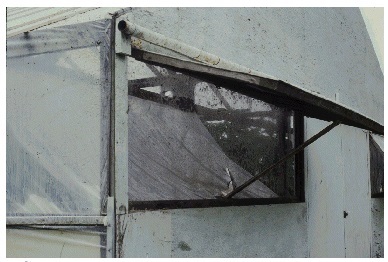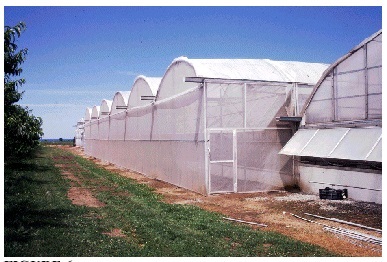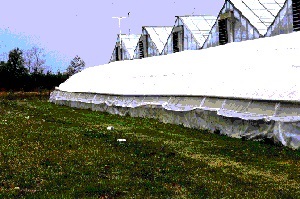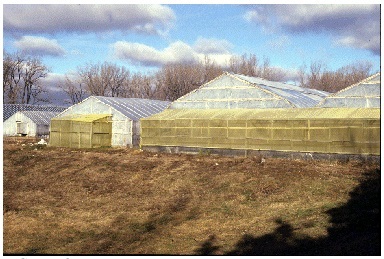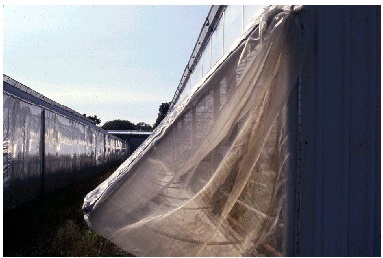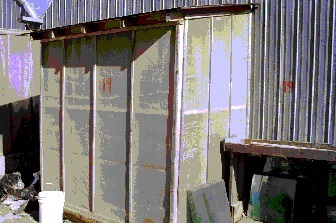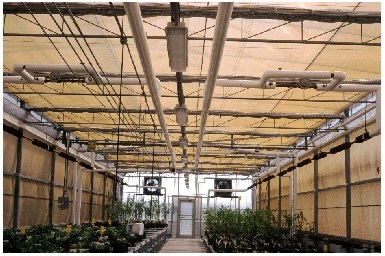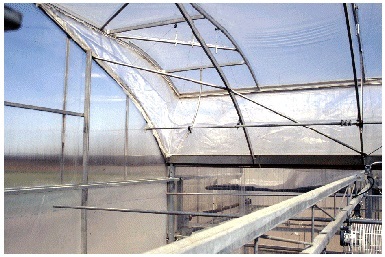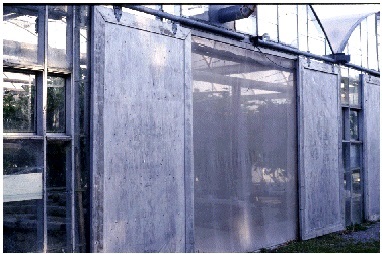Screening of greenhouses for insect exclusion
Learn how screening of greenhouses can be an effective tool to prevent the movement of pests into the greenhouse from the outside.
ISSN 1198-712X, Published February 2000
Introduction
Integrated Pest Management (IPM) of greenhouse crops includes strategies such as monitoring, and cultural, chemical and biological controls. It also includes physical controls such as screening to exclude flying insect pests. While screening has been a textbook component of IPM programs for many years, until the mid-1990s it was rarely used in Ontario. Today, some growers have retrofitted (usually small) areas of their greenhouses with insect exclusion screening.
Screening removes an important variable from a grower's pest management program - the movement of pests into the greenhouse from outside. This includes common greenhouse pests such as thrips, aphids, and whiteflies, but also some less common pests such as tarnished plant bug and European corn borer. These can become major pest problems if you use biological control programs to reduce pesticide use. Benefits of using insect screening have been demonstrated in Israel and California. In Ontario, growers who installed screens report reduced pest levels and pesticide use, and improved effectiveness of pest control measures (especially biological control).
Target pests
First, you must determine which pests you need to exclude. The size of the pest determines the mesh size of the screen needed. Large mesh sizes of the type normally found in household screens are inadequate for excluding most major greenhouse pests. However, they can keep out occasional larger pests such as tarnished plant bug and lepidopteran (moth) pests. For the more common pests, smaller mesh sizes are needed (Table 1). When you have multiple pests of concern, choose a mesh size to exclude the smallest of these pests.
| Pest | Minimum Mesh Size for Exclusion |
|---|---|
| Leafminer (Liriomyza trifolii) | 608µ |
| Green peach aphid (Myzus persicae) | 434µ |
| Melon aphid (Aphis gossypii) | 355µ |
| Greenhouse whitefly (Trialeurodes vaporariorum) | 288µ |
| Silverleaf whitefly (Bemisia argentifolii) | 239µ |
| Western flower thrips (Frankliniella occidentalis) | 215µ |
Effectiveness
Data from trials in commercial greenhouses in the Niagara region show that screening can: (a) delay the onset of a thrips infestation, (b) significantly reduce thrips levels inside greenhouses, and (c) facilitate a sustained reduction in thrips populations in greenhouse crops. Figure 1 shows monitoring results from a commercial greenhouse growing cut roses in Ontario, and emphasizes the relationship between thrips entering the greenhouse from the outside, and the trap catches of thrips on the inside.

Accessible description of Figure 1
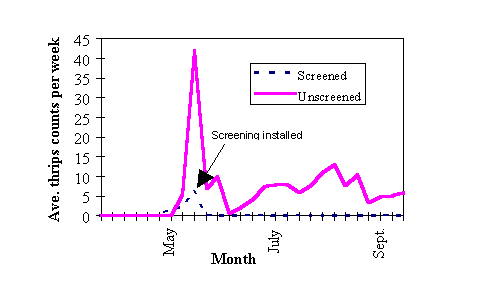
Accessible description of Figure 2
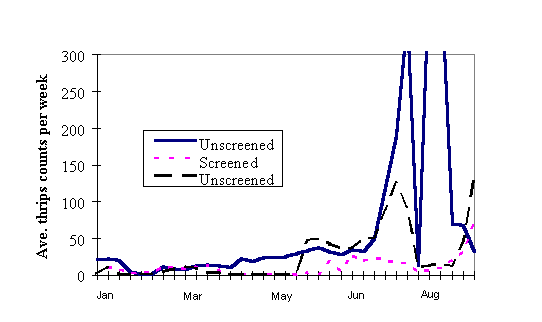
Accessible description of Figure 3
Ventilation
A major concern of growers considering screening is the reduction in air flow. Reduced air flow can lead to overheating of the greenhouse, and stress on the fans (in the case of fan-ventilated greenhouses) that have to work harder to pull the same amount of air through the partially-blocked vent. Reduced ventilation is a valid concern, but it can be addressed by increasing the surface area of the vent. In many situations this is done successfully by building a screened framework around the vent opening. The goal is to ensure that the final surface area of the vents provides sufficient air exchange to allow adequate cooling of the greenhouse.
Several methods are available to determine the increase in surface area of the vents required for any given greenhouse. Factors such as screen mesh size, fan capacity, and static pressure drop (the difference in air pressure between inside and outside the greenhouse when the fans are running) are important. Although software programs exist, the calculations can be complicated and are generally best left to the screening manufacturers.
Screening structures
The type of screening structure you install depends on:
- whether you need to increase surface area to maintain adequate ventilation, and
- the type of ventilation and vent openings - passive vs. forced, positive vs. negative pressure, side vents vs. peak or gutter vents.
In general, passively-vented greenhouses are more difficult to screen and ventilation through them may not be as effective as in forced ventilation systems. Some options for growers are shown in the following photographs.
Screening of side vents
Screening of fans
Screening of roof peak vents
Screening of gutter vents
Screening of doorways
Maintenance and cleaning of screens
The small pore size means screens are very prone to blockage with dust and other deposits, especially in the summer. Such blockage reduces air flow through the screens and may contribute to excessively high temperatures. It is therefore important to clean the screens regularly. It is also important, when designing your screens, to ensure easy access to them for cleaning. Wash screens from the inside with a high pressure hose.
Do not do this when the fans are operating, because the water will block the pore openings and completely stop air flow, leading to overheating of the greenhouse.
The effectiveness of the screens depends on their ability to exclude flying insects. Repair tears and holes as soon as possible. You can repair small tears by simply gluing a piece of screening over the hole.
Durability
When buying screening, consider the durability and longevity of the product. The longevity of the screen depends on how it is made, what it is made of, and how it is installed.
For example - see Figure 7 and Figure 10.
Consider how susceptible the screening will be to damage from equipment, lawn mowing debris, entry by mice or other animals.
Most commercial screens on the market are reported to have a life span from 3 to 5 years, based on manufacturer claims.
Costs
The cost of screening depends on several factors:
- the final screening design
- the increase in surface area needed to maintain adequate ventilation
- the cost of the screening material
- whether roof vents or side vents are to be screened
- the frequency of replacement; frequency of cleaning.
The biggest variable is the difference in cost between installing screens in a force-ventilated, side-vented greenhouse, and a passively-vented greenhouse with roof vents. Nevertheless, reports from growers who have installed screens over side vents in force-ventilated greenhouses, suggest a rapid payback from reduced pesticide costs and improved pest management.
Additional reading
Baker J.R., Bell M.L. and Shearin E.A. (1997). Insect Screening. Information Note 104: Ornamentals and Turf, Integrated Pest Management. North Carolina Cooperative Extension Service. NCSU, 4 pp.
Bell M.L and Baker J.R. (1997). Choose a greenhouse screen based on its pest exclusion efficiency. North Carolina Flower Growers' Bulletin. 42(2):7-13.
Bethke J. A. (1994). Considering Installing Screening? This is what you need to know. Greenhouse Manager, April 1994, 34-36.
Hahn R.H. and Rosentreter E.E. (1989). Heating, Ventilating and Cooling Greenhouses. In: ASAE Standards, R.H. Hahn and E.E. Rosentreter (eds.), 452-455.
National Greenhouse Manufacturers Association. Insect Screening - Greenhouse Insect Screen Installation Considerations for Greenhouse Operators (Copyright Pending 1996).
Sase S. and Christianson L.L. (1990). Screening Greenhouses - Some Engineering Considerations. Proceedings of the 1990 Northeast Agricultural/Biological Engineering Conference; 1-13.
Willits, D.H. (1993). Greenhouse Cooling. North Carolina Flower Growers' Bulletin. 38(2): 15-18.
Accessible image descriptions
Figure 1. Thrips populations in a rose crop as monitored by sticky cards; a) in the vent opening, b) in the greenhouse closer to the vents, and c) in the greenhouse away from the vents.
Thrips populations in a rose crop as monitored by sticky cards in the vent opening peaked on the 22nd of September at 105 thrips per sticky card per vent.
Thrips populations in a rose crop as monitored by sticky cards in the greenhouse closer to the vents peaked on the 24th of September at 80 thrips per sticky card per vent
Thrips populations in a rose crop as monitored by sticky cards in the greenhouse away from the vents remained fairly constant. It was highest on the 11th of August with about 18 thrips per sticky cards per vent.
Figure 2. Thrips populations in screened vs. non-screened greenhouses.
The thrips population in an unscreened greenhouse peaked in early-May at 43 thrips counts per week. While in a screened greenhouse, the thrips peaked also in early-May but at 7 thrips counts per week.
Figure 3. Thrips populations on sticky cards in 1998 in a screened vs. 2 adjacent unscreened compartments.
In the first unscreened compartment, the thrips population peaked off the charts in early-August at above 300 thrips counts per week.
In the second unscreened compartment, the thrips population was high in mid-June with thrips populations at 140 thrips counts per week, and again in late-August at about 150 thrips counts per week.
In the screened compartment, the thrips populations peaked in late-August at about 80 thrips counts per week.

